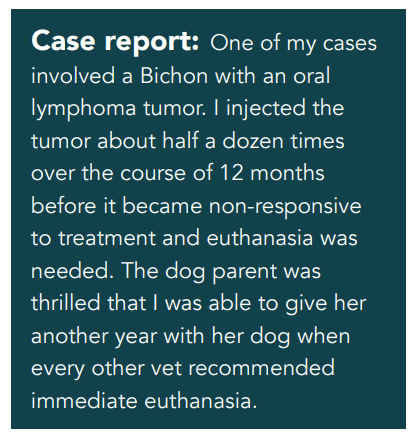Could intralesional chemotherapy be an option for your dog or cat?

Because it directly targets tumors while bypassing systemic circulation, intralesional chemotherapy produces fewer side effects in dogs and cats than traditional chemo. Find out if this innovative cancer treatment might be right for your own animal.
Every year, I treat many dogs and cats with cancer. I’m happy to be able to offer a holistic approach for these animals, most of whom will not benefit from chemotherapy, but will benefit from detoxification and immune support. Sometimes traditional chemotherapy is helpful for selected animals, but if possible, I prefer intralesional chemotherapy rather than oral or injectable chemo. In this article, I’ll discuss this exciting treatment and its application for dogs and cats.
What is intralesional chemotherapy?
An exciting way to treat animals with solid tumors in to inject the tumors directly with the chemotherapy medicine. Certain solid tumors respond beautifully to injectable chemotherapy. (In my practice, I also inject various herbs and homeopathics to stimulate an immune, anti-inflammatory, and detoxifying response.)
Intralesional chemotherapy puts the drug right into the tumor, bypassing the systemic circulation (the drug is eventually picked up by the systemic circulation, but at lower doses than if injected systemically, minimizing or eliminating side effects). This allows very little of the chemotherapy drug to affect the body at one time, but puts large amounts directly into the cancer cells that make up the tumor.
 Cancers that respond to intralesional chemo
Cancers that respond to intralesional chemo
Here are some cancers which may respond to intralesional chemotherapy (and have in my own practice):
Soft tissue sarcomas
In dogs, isolated soft tissue sarcomas can often be removed surgically. This can be curative, but for tumors on the limbs, amputation may be needed as these sarcomas recur following surgery.
To minimize recurrence, or in place of surgery, intralesional 5-FU can be injected into the tumor. If this injection is done in addition to surgical removal, I inject the area around the tumor at the time of surgery to try to kill any remaining cancer cells. Alternatively, the injection can be done post-operatively, usually under mild sedation. I have had good success with this therapy. Although a cure may not be possible on limb tumors, the injections can be repeated as needed and I’ve never seen side effects. However, 5-FU cannot be used in cats, as it is fatal in this species.
Isolated lymphoma
While lymphoma is usually a systemic disease requiring systemic chemotherapy for rapid remission, a solitary lymphoma tumor occasionally arises. For these cases, I’ll inject a corticosteroid directly into the tumor (always under sedation to make it comfortable for the patient). Because cancerous lymphocytes are easily killed by steroids, this treatment typically causes the tumor to shrink or disappear almost overnight. However, this will not usually cure the animal, as the tumor can recur. Additional injections are given as frequently as needed, but at some point the cancerous lymphocytes will develop resistance to the injected steroids, making intralesional chemo no longer effective.

Mast cell tumors
This is yet another tumor that responds well to intralesional corticosteroid injection. While I prefer to remove these tumors (especially when they are small at the time of diagnosis), in cases where the tumor is too large to remove or the client prefers not to do surgery, I will inject the tumor in an attempt to shrink it (to make it easier to remove) or cure it if surgery is not an option. I also inject the surgery site post-op to kill any remaining cancer cells. I have had good success with this treatment for mast cell cancer.
 Immune support and detoxing also important
Immune support and detoxing also important
Keep in mind that I never use intralesional chemo as the sole treatment for patients with cancer. This therapy is used as an adjunct to immune support and detoxification that involves herbal, homeopathic, and nutritional treatment, and with surgery, traditional chemo, or radiation in those few cases that might benefit from conventional therapies.
I also typically inject herbs/homeopathics into and around the tumor at the same time as I administer the intralesional chemotherapy. This is done to stimulate local immunity, achieve local control of inflammation, and detoxify the area surrounding the cancer.
Intralesional chemotherapy is safe, requires minimal sedation, can be repeated, is practically devoid of side effects, and is much less expensive than systemic chemo or surgery. While these other therapies may still be needed to achieve systemic cancer control, intralesional chemo is an exciting alternative that is worth discussing with your veterinarian.



